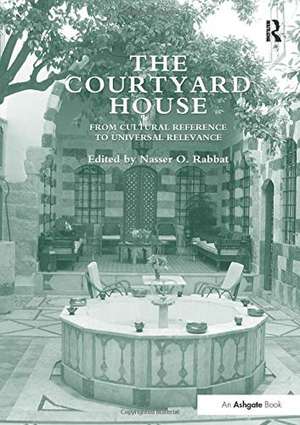The Courtyard House: From Cultural Reference to Universal Relevance
Editat de Nasser O. Rabbaten Limba Engleză Paperback – 23 sep 2016
| Toate formatele și edițiile | Preț | Express |
|---|---|---|
| Paperback (1) | 397.48 lei 3-5 săpt. | +20.86 lei 7-13 zile |
| Taylor & Francis – 23 sep 2016 | 397.48 lei 3-5 săpt. | +20.86 lei 7-13 zile |
| Hardback (1) | 823.17 lei 6-8 săpt. | |
| Taylor & Francis – 28 aug 2010 | 823.17 lei 6-8 săpt. |
Preț: 397.48 lei
Preț vechi: 432.04 lei
-8% Nou
76.06€ • 79.62$ • 62.93£
Carte disponibilă
Livrare economică 15-29 martie
Livrare express 01-07 martie pentru 30.85 lei
Specificații
ISBN-10: 1138246859
Pagini: 290
Dimensiuni: 174 x 246 x 19 mm
Greutate: 0.45 kg
Ediția:1
Editura: Taylor & Francis
Colecția Routledge
Locul publicării:Oxford, United Kingdom
Cuprins
Recenzii
'... students of vernacular architecture will find the earlier essays especially valuable [and] the book will also appeal to those with interests in the particular regions and cities discussed.' International Journal of Islamic Architecture
Notă biografică
Descriere
The courtyard house is one of the most enduring architectural forms, transcending regional, historical and cultural boundaries. Its balance of simple appropriate construction, environmental control and social and familial structures continues to engage architects and architectural historians. That the courtyard house is still relevant today is indicated through its ability to accommodate continual transformation without losing any of its formal integrity and cultural roots. This book presents a series of viewpoints on courtyard houses from different periods and in different regions around the world; from the Harem courtyards of the Topkapi Palace and the low-cost housing settlements of Protectorate Casablanca, to contemporary design strategies for courtyard houses in the arid Gulf region. Together, the essays illuminate issues of particular relevance in architectural, art historical, and conservation discourses today.







